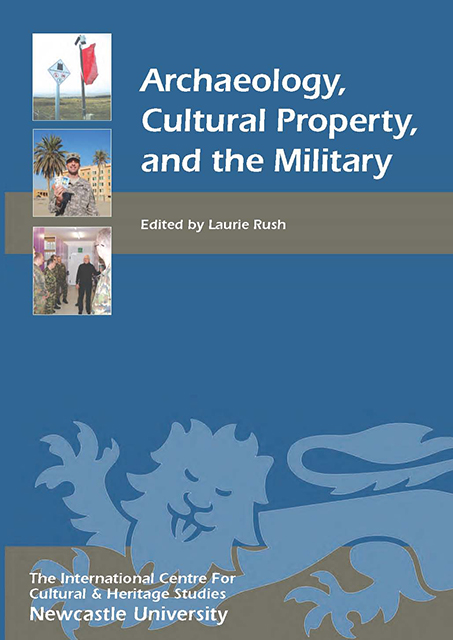Book contents
- Frontmatter
- Contents
- List of Illustrations: Figures and Tables
- Archaeology and the Military: An Introduction
- 1 The Obligations Contained in International Treaties of Armed Forces to Protect Cultural Heritage in Times of Armed Conflict
- 2 Rescuing Europe’s Cultural Heritage: The Role of the Allied Monuments Officers in World War II
- 3 The UK’s Training and Awareness Programme
- 4 US Army Civil Affairs: Protecting Cultural Property, Past and Future
- 5 Cultural Property Protection in the Event of Armed Conflict: Deploying Military Experts or Can White Men Sing the Blues?
- 6 Good Training and Good Practice: Protection of the Cultural Heritage on the UK Defence Training Estate
- 7 In-Theatre Soldier Training through Cultural Heritage Playing Cards: A US Department of Defense Example
- 8 Dealing the Heritage Hand: Establishing a United States Department of Defense Cultural Property Protection Program for Global Operations
- 9 Teaching Cultural Property Protection in the Middle East: The Central Command Historical/Cultural Advisory Group and International Efforts
- 10 Cultural Resources Data for Heritage Protection in Contingency Operations
- 11 Time not on my Side: Cultural Resource Management in Kirkuk, Iraq
- 12 US Military Support of Cultural Heritage Awareness and Preservation in Post-Conflict Iraq
- 13 Operation Heritage
- 14 Cultural Property Protection in the Event of Armed Conflict – Austrian Experiences
- 15 The Role of the Swiss Armed Forces in the Protection of Cultural Property
- 16 Preserving Global Heritage from Space in Times of War
- Appendix 1 1954 Hague Convention and its two Protocols
- Appendix 2 Author Biographies
- Index
15 - The Role of the Swiss Armed Forces in the Protection of Cultural Property
Published online by Cambridge University Press: 28 February 2023
- Frontmatter
- Contents
- List of Illustrations: Figures and Tables
- Archaeology and the Military: An Introduction
- 1 The Obligations Contained in International Treaties of Armed Forces to Protect Cultural Heritage in Times of Armed Conflict
- 2 Rescuing Europe’s Cultural Heritage: The Role of the Allied Monuments Officers in World War II
- 3 The UK’s Training and Awareness Programme
- 4 US Army Civil Affairs: Protecting Cultural Property, Past and Future
- 5 Cultural Property Protection in the Event of Armed Conflict: Deploying Military Experts or Can White Men Sing the Blues?
- 6 Good Training and Good Practice: Protection of the Cultural Heritage on the UK Defence Training Estate
- 7 In-Theatre Soldier Training through Cultural Heritage Playing Cards: A US Department of Defense Example
- 8 Dealing the Heritage Hand: Establishing a United States Department of Defense Cultural Property Protection Program for Global Operations
- 9 Teaching Cultural Property Protection in the Middle East: The Central Command Historical/Cultural Advisory Group and International Efforts
- 10 Cultural Resources Data for Heritage Protection in Contingency Operations
- 11 Time not on my Side: Cultural Resource Management in Kirkuk, Iraq
- 12 US Military Support of Cultural Heritage Awareness and Preservation in Post-Conflict Iraq
- 13 Operation Heritage
- 14 Cultural Property Protection in the Event of Armed Conflict – Austrian Experiences
- 15 The Role of the Swiss Armed Forces in the Protection of Cultural Property
- 16 Preserving Global Heritage from Space in Times of War
- Appendix 1 1954 Hague Convention and its two Protocols
- Appendix 2 Author Biographies
- Index
Summary
INTRODUCTION
On 11 December 1961 the Swiss government, or Federal Council as it is more commonly known, issued its ‘Message to the Federal Parliament concerning Swiss accession to the 1954 Hague Convention for the Protection of Cultural Property in the Event of Armed Conflict. An extract reads as follows:
It would be fanciful to assume that the means exist to save with absolute certainty the entire cultural heritage of a country at war. Yet, experience has shown that it is possible to mitigate this risk. The Convention, agreed in The Hague in 1954 by many countries and inspired by the desire for greater cooperation and designed in the spirit of mutual respect, deserves our support not least because of its important moral significance. We would also be in the fortunate position of being able to invoke its provisions, were a war and its concomitant suffering to break out across our country.
In the intervening 38 years, much has changed in Switzerland with regard to the protection of cultural property. The threat from a conventional war involving combined aerial and ground attacks has largely dissipated, which is good news for both the country as a whole and its cultural property. However, new threats have emerged over the last 20 years or so. Cultural property has increasingly become the target of choice in civil and ethnic conflicts, a development which the Swiss Peace Corps has seen for itself during its mission in Kosovo. In security service circles, there is a growing concern that cultural property could be a potentially attractive target also for terrorist groups.
Nevertheless, the statement by the Federal Council is as relevant today as it was in 1961. The only difference is that the protection of cultural property, the responsibility for which is shared in Switzerland and elsewhere by the military and civilian authorities, must be adapted to these new threats and changing circumstances.
This chapter has two aims. The first is to present the Protection of Cultural Property (PCP) model adopted by the Swiss Armed Forces, and the changes it already has undergone. The second is to conjecture on the further changes that may be required in the future.
- Type
- Chapter
- Information
- Archaeology, Cultural Property, and the Military , pp. 159 - 166Publisher: Boydell & BrewerPrint publication year: 2010



